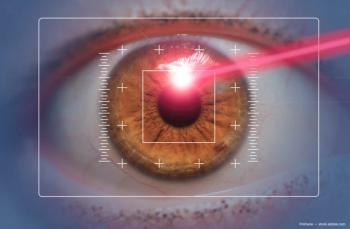
Kodiak announces new data from APEX study of KSI-101
Key Takeaways
- KSI-101 showed significant visual and anatomical improvements in MESI and DME, with a favorable safety profile in the APEX study.
- The bispecific mechanism of KSI-101 targets IL-6 and VEGF, offering potential advantages over current treatments like intraocular steroid implants.
Kodiak Sciences announced new data from the APEX study of KSI-101 for the treatment of patients with macular edema secondary to inflammation (MESI).1
The data, which demonstrated subjects experiencing a clinically meaningful gain in best-corrected visual acuity (BCVA) and rapid retinal drying from baseline to week 12, were presented by Charles Wykoff, MD, PhD, Deputy Chair of Ophthalmology, Blanton Eye Institute, at the Retina Society 58th Annual Scientific Meeting held September 10-13 in Chicago.
With currently no good treatment options, MESI is a heterogenous group of serious vision-threatening retinal diseases that clinically present with macular edema and visual impairment.1 KSI-101 is a novel, potent, and high-strength (100 mg/mL) antibody-based investigational therapy with a bispecific mechanism of action targeting interleukin-6 (IL-6) and VEGF.1
“Although early in development, KSI-101 appears to be emerging as a powerful, dual-action, safe investigational therapy with potential applicability to a diverse set of pathologies that have relevance to retina specialists and uveitis specialists, many diseases of which currently have no approved treatment,” Wykoff said.
The phase 1b APEX study evaluated KSI-101 in two cohorts—cohort 1 in patients with diabetic macular edema (DME) and cohort 2 in patients with MESI. APEX’s dose-findings demonstrated that KSI-101 provides meaningful visual and anatomical gains in both DME and MESI, as well as that KSI-101 was well-tolerated across cohorts. In the DME cohort, it was found that subjects had meaningful visual and anatomical gains with KSI-101, with patients gaining 12.0 letters and decreasing 157 microns in OCT CST from baseline to week 24.1
“The APEX data with KSI-101 bispecific antibody showed a drying effect that is on par with or even better than expected with the intraocular steroid implants such as Ozurdex but with none of the side effects,” Sumit Sharma, MD, retina and uveitis specialist at the Cleveland Clinic’s Cole Eye Institute, said in a press release.1
“This is a fantastic effect, and if replicated in the ongoing phase 3 studies, KSI-101 could significantly change how we treat the many patients with macular edema secondary to inflammation.”
The top two dose levels (5 mg and 10 mg) of KSI-101 were selected to advance to the PEAK (
PEAK includes patients with more severe disease, while PINNACLE includes patients with milder disease and patients with moderate to severe macular edema with good vision.1 PEAK and PINNACLE are designed to enroll complementary patient populations to cover a wide spectrum of MESI patients.1
Patients randomized to the KSI-101 treatment arms will receive fixed monthly dosing for 6 doses from day 1 to week 20, with subsequent individualized dosing for 6 additional visits (week 24 to week 44).
“As a retina community, we look forward to continuing our collaboration with Kodiak as they advance their portfolio of three late-stage medicines targeting a broad range of retinal diseases through their ongoing phase 3 GLOW2, DAYBREAK, PEAK, and PINNACLE studies,” Wykoff said.
Reference:
Kodiak Sciences Inc. New data for Kodiak’s KSI-101 from the APEX study reinforce its clinically meaningful vision gains and rapid retinal drying in macular edema secondary to inflammation (MESI). Prnewswire.com. Published September 15, 2025. Accessed September 16, 2025.
https://www.prnewswire.com/news-releases/new-data-for-kodiaks-ksi-101-from-the-apex-study-reinforce-its-clinically-meaningful-vision-gains-and-rapid-retinal-drying-in-macular-edema-secondary-to-inflammation-mesi-302555986.html
Newsletter
Don’t miss out—get Ophthalmology Times updates on the latest clinical advancements and expert interviews, straight to your inbox.















































.png)


